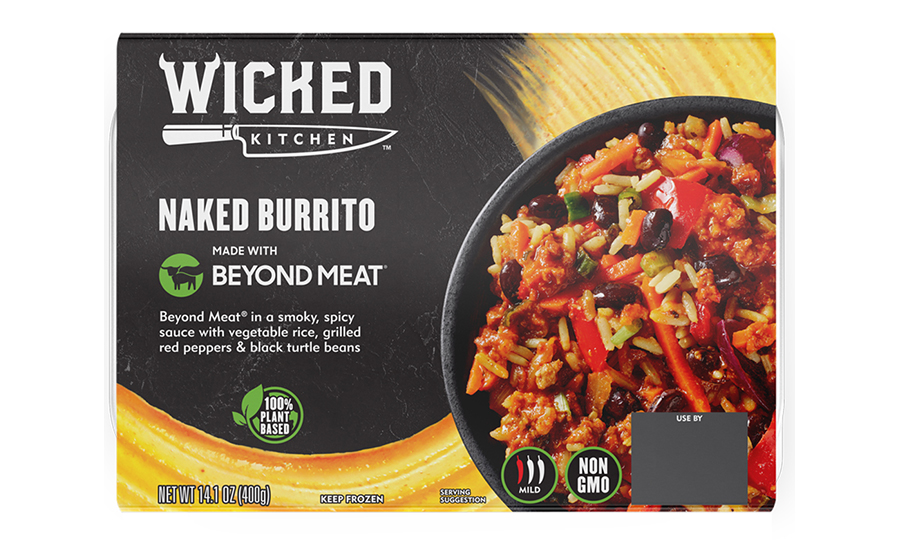STATE OF THE INDUSTRY: 2022
Prepared Meal, Entrée and Pizza Producers Stay Busy to Keep Consumers Happy, Healthy with At-Home Options
Overall competition for meal solutions is increasing as the restaurant industry rebounds

PHOTO CREDIT: Getty Images / DGLimages

Less is More! Conagra Brands boosts appeal by cutting carbs, sugar.
PHOTO COURTESY OF: Conagra Brands

New Name to Know. After UK success, Wicked Foods brings popular plant-based line to US markets.
PHOTO COURTESY OF: Wicked Foods

Ready to Travel? Ilinel Food Company debuts with authentic Latin American meal options.
PHOTO COURTESY OF: Ilinel Food Company

Keep it Fresh. FreshRealm debuts with more than 50 Kitchen Table brand refrigerated ready meals.
PHOTO COURTESY OF: FreshRealm LLC

Say Cheese! Lily’s Toaster Grills line expands hand-held options.
PHOTO COURTESY OF: Lily’s Toaster Grills LLC

Keto Keeps Growing. New keto-friendly pizzas expand freezercase options.
PHOTO COURTESY OF: Cappello’s







Want to picture the prepared meal and entrée market? Think of it as one of those connect-the-dots drawings. It might take a little while to see a pattern and complete. Yet don’t worry—it’s going to look nice.
Overall competition for meal solutions is increasing as the restaurant industry rebounds. Industry market and consumer insights tracker NPD Group, Chicago, says the US restaurant industry ended 2021 better than the year began. Moreover, NPD predicts industry operators could recover 98% of pre-pandemic visits by the end of 2022.
However, here’s an interesting first “dot” of reference. In another report, NPD looked at lunchtime eating occasions and found that—in addition to returning to restaurants for lunch—consumers have returned to convenient ways to prepare or source lunch. During the height of the pandemic, when many consumers were home, they had more time to heat their lunches, driving categories like soup and warm sandwiches. Now, with workplaces starting to open, kids at school, consumers working from home, and travelers returning to the road, easily transported categories such as packaged lunch and snack kits, are positioned to do well through 2024, finds the NPD study. Consumers will also look to retail ready-to-eat foods for convenient lunches
Consider another dot in the picture. NPD says that during the pandemic, consumers increased their capacity for preparing meals at home, aided by a whole host of new appliances and gadgets in the kitchen. Kitchen electrics grew by $2.9B, or a 37% gain over the prior year; more than 91% of kitchen electric subcategories increased during the pandemic. Bottom line, there will likely be some “stickiness” to a year’s worth of at-home culinary engagement and investment in housewares and appliances.
Finally, NPD itself put these and other trends together for its 36th edition of Eating Patterns in America. Its conclusion: a home-centric lifestyle already in play for US consumers before the pandemic—is poised to continue long-term.
“Our life stage and workplace behavior has a lot to do with how, where, and when we consume foods and beverages, and what we buy to help us prepare our meals,” says David Portalatin, NPD food industry advisor and author of Eating Patterns in America. “These factors transcend the crisis of the moment or boom time economy that might replace it and will continue to influence behaviors over the long-term.”
NPD reports that in 2014, US consumers sourced 82% of their meals from the home, which increased to 83% in 2019. During the pandemic, meals sourced from home rose to 86%. As restrictions on restaurants and stay-at-home orders have lifted, some meal occasions have shifted back to restaurants, but home-centric eating behaviors have some staying power.
Whether foods and beverages are from retail or restaurants, Portalatin says providing in-home meal solutions will be the “sweet spot” for retailers, restaurant operators, and supply chain partners.
More In-store
Among those vying for that “sweet spot” are freezercase giants Nestlé USA, Arlington, Va., and Conagra Brands, Chicago.
Last spring saw Nestlé combine two “comfort food classics” with new Stouffer’s LasagnaMac, which features creamy, cheesy macaroni and cheese and layers of lasagna. Then in October, the company added 10 new varieties to its Life Cuisine line, which targets high protein, meatless, gluten free and low-carb lifestyle diets. Two new Life Cuisine offerings incorporate chickpea pasta from Banza LLC (co-branded on packaging) for gluten-free appeal.
It was last summer when Conagra announced new products across all its brands including Healthy Choice, Banquet, Marie Callender's and Hungry Man. Leading the way are Healthy Choice Zero meals, each with fewer than 10 net carbs and no added sugar. The brand also went “big” with Healthy Choice Max—featuring 40% more food than its regular Healthy Choice Power Bowls. Another core brand, Birds Eye, introduced Sheet Pan Meals. They use just one pan, are ready in 25 minutes and come in four varieties: Chicken with Balsamic Flavored Sweet Potatoes, Chicken with Rosemary Brown Butter Potatoes, Italian Sausage with Peppers and Chicken with Garlic Parmesan Potatoes.
Also targeting the freezercase were various processors including Path of Life, Naperville, Ill.; The Real Good Food Company, Inc., Cherry Hill, N.J., and Wicked Kitchen, Minneapolis. And last year even saw home entertaining celebrity Martha Stewart join the fun.
Frozen grains processor Path of Life branched into frozen entrees with Organic Grains & Broccoli with Hearty Tomato Pesto Seasoning. Real Good Foods was active with four new low-carb, high-protein items: two Grande Enchiladas and two Stuffed Chicken Breasts (Bacon Wrapped, Creamy Spinach & Artichoke). After thriving with Tesco in the United Kingdom since 2018, Wicked Kitchen set up offices in Minneapolis last year and introduced more than 20 plant-based items in the US, including lunch and breakfast options, frozen ready meals and a range of meal solutions with sauces, mayos, pestos and meal kits.
Well known to consumers—but new to the freezercase—was home entertaining celebrity Martha Stewart. Her MSK Foods company and Martha Stewart Kitchen brand partnered with Marquee Brands, New York, N.Y., on a 40-item frozen line ranging from frozen appetizers and desserts to entrées, side dishes, ready-to-heat grain blends, and seasonal vegetables.
Exploring still more new “pastabilties” were Cappello’s, Denver; and Buitoni Food Company (Brynwood Partners) Stamford, Conn. Last spring saw Cappello’s introduce two grain-free frozen ravioli. For its part, Buitoni partnered with Impossible Foods to launch two refrigerated ravioli items: Buitoni made with Impossible Beef and another featuring Impossible Italian Sausage.
The freezercase saw two more Italian food-inspired launches. Flash freezing specialist Cadence Kitchen, Corona, Calif., introduced Gluten-Free Pasta with Chicken in A Cheese & BBQ Sauce, and a Five Cheese Fiocchetti with Beef Bolognese. Last fall also marked the debut of Eathos Foods, a Watsonville, Calif., firm specializing in frozen “traditional Italian comfort foods.” Its initial line includes five vegetarian entrees and four plant-based vegan recipes—with ingredients imported from Parma, Italy.
Ready to rise and dine? After fast-paced new product activity in 2020, Tyson’s Jimmy Dean brand was not as busy last year. Even so, other manufacturers eyed opportunity in heat-and-eat breakfasts. Active in the freezercase was Nestle’s Sweet Earth Foods, Moss Landing, Calif., which introduced three new plant-based Sweet Earth Breakfast Bowls. Another California company, Alpha Foods Inc., Glendale, introduced five new meatless breakfast offerings—including three breakfast burritos and two new breakfast sandwiches.
Meanwhile, the refrigerated case saw new activity from Bob Evans Farms, New Albany, Ohio, which introduced three varieties of Bob Evans Omelet Rolls and three varieties of new Bob Evans Egg Bites.
There also are hand-held options for lunch and other on-the-go moments. Last fall saw American Halal Company Inc., Stamford, Conn., introduce premium frozen Saffron Road Artisan Wraps in three varieties: Bean & Cheese, Samosa with Chickpeas, and Butter Chicken. For those with more traditional tastes, Lily’s Toaster Grills LLC, Denver, offers a five-item line of frozen grilled cheese-based sandwiches (most including meat). After a brief thaw in the microwave, they’re designed to heat and serve straight from the freezer.
Keep it Fresh!
Refrigerated meals and entrées are becoming big business. For starters, last fall saw The Kroger Company announce its Home Chef business (acquired in 2018) reached $1 billion in annual sales. The Chicago-based operation still supplies the nationwide meal kit delivery market. It also supplies refrigerated, prepackaged meals to as many as 2,200 Kroger-owned stores.
In other news, nationwide meal shipper Freshly Inc. (Nestlé USA), introduced Freshly Purely Plant, an initial six-item line of ready-to-heat, finished plant-based meals. Customers can order as part of Freshly’s 4, 6, 8, 10, or 12-meal plans starting at $8.49 per meal at www.freshly.com.
Last fall also marked the debut of FreshRealm LLC, Ventura, Calif. Its new Kitchen Table line includes more than 50 complete meal options that are ready in three to 20 minutes by oven, stovetop, microwave and slow-cooker.
Have Tastebuds. Will Travel
Global pandemic conditions mean consumers still aren’t traveling at pre-COVID rates. Even so, manufacturers are bringing the world to the retail shelf—particularly with Asian and Hispanic flavors.
While Korean foods and flavors rule in other categories (particularly sauces), dishes from India, Thailand and China are capturing taste buds in the entrée realm. Last year saw Saffron Road, Stamford, Conn., introduce two shelf-stable Indian meals (plant-based, protein-powered Coconut Curry, Bombay Lentils) as well as three new frozen entrees from Thai, Indian and Chinese traditions: Pineapple Fried Rice with Chicken, Butter Chicken, and Sweet & Sour Chicken (the brand’s first foray in Chinese).
Many more new offerings follow Hispanic food leanings across all product categories.
Staying in the freezercase was SANA Foods (The Real Coconut Products Co. LLC), a plant-based Los Angeles company whose products also are gluten, grain and dairy-free. Last fall saw officials announce the category’s first two grain-free frozen burritos (Traditional, Fajita). Vegan and paleo compliant, the burritos use cauliflower rice and breadfruit as a bean substitute. They’re wrapped with SANA’S organic coconut flour tortillas. Also targeting the freezercase last spring was Menu Del Sol taquito maker Sigma US, Phoenix. Officials say Sigma plans to dramatically expand its frozen entrée offerings in the category.
Other groups have eyed opportunity in Hispanic shelf-stable meals. Former KIND Snacks executives Daniel Lubetzky, Miguel Leal and Rodrigo Zuloaga formed SOMOS Foods, Austin, Texas. This January the new brand launched authentic Mexican slow cooked rices, beans, tortilla chips, salsas, and vegetarian entrees like smoky chipotle mushrooms; cauliflower tinga; and two kinds of peacadillo (SOMOS' own plant-based alternative to Mexican picadillo).
Also eyeing the market has been Mariposa Group, Grupo Apex and Engine4 Ventures, New York, N.Y. Engine4 Ventures is parent to Ilinel Food Company, which also launched a new line this January: Casa Verde plant-based Latin entrees. An initial four authentic Latin-inspired entrees include Garbanzos Al Pastor, Lentil Mole, Coconut Chowder, and Red Bean Pozole.
Slice of Life
How about another COVID comfort food—pizza? This category remains quite active with entries to address every appetite.
Category leader Nestlé USA (DiGiorno, Tombstone, Jack’s, Outsider’s, California Pizza Kitchen) bolstered its DiGiorno line last spring with two new gluten free offerings. Last fall, it came back with full-flavored DiGiorno Original Rising Crust Mac & Cheese Pizza (rolling out now).
Category contender Schwan’s Company (CJCJ Food Americas) is parent to the Freschetta, Red Baron and Tony’s brands. After a busy 2020, the company introduced three varieties of Red Baron Fully Loaded Pizza last fall.
Among those seeing new opportunity was the digital media company Barstool Sports, New York, N.Y., which partnered with Happi Foodi (Waffle Waffle LLC) Secaucus, N.J., to develop and launch four varieties of One Bite frozen pizza. Officials say Barstool Sports' Founder and President Dave Portnoy's “One Bite” pizza review series is the most engaged pizza show on the internet.
Promoting new diet-friendly choices was Cappello's, which introduced Keto Certified frozen pizza. Chickpea comfort food specialist Banza, New York, also expanded its line of frozen chickpea-based pizzas with two new varieties: Supreme (vegetarian), and Plant-Based Cheese (vegan).
Looking for a reprint of this article?
From high-res PDFs to custom plaques, order your copy today!













